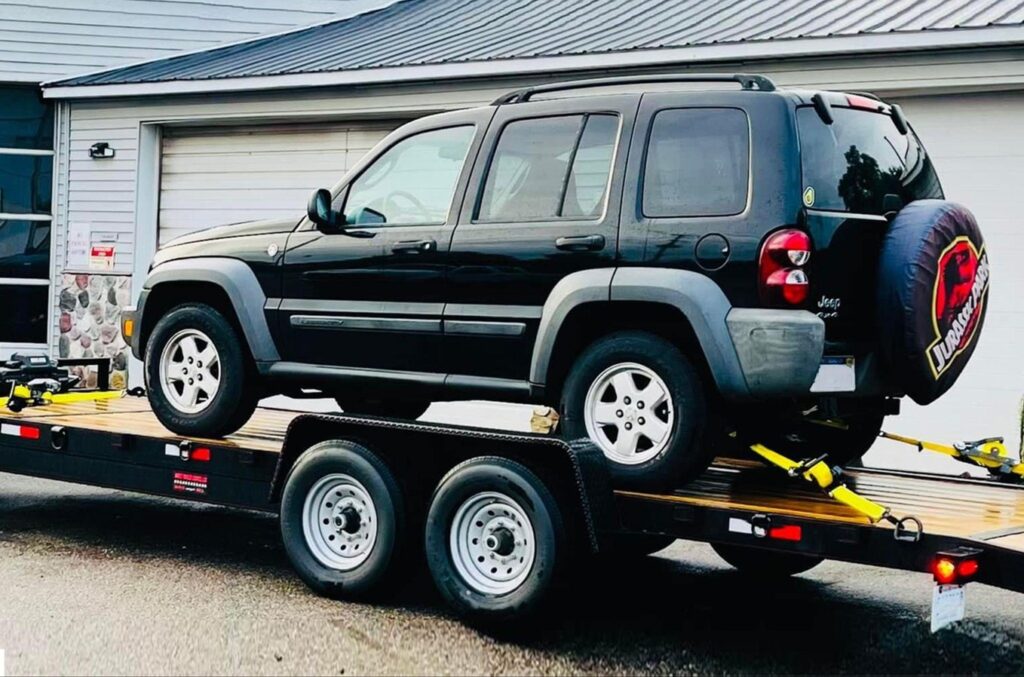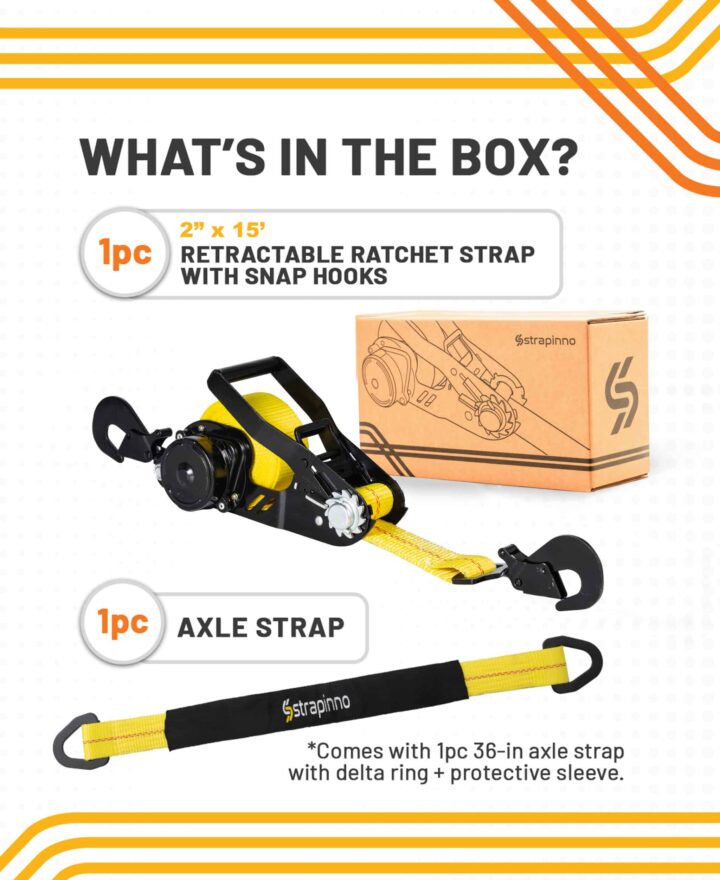How to Tie Down a Car on a Trailer: Securing Cars With Retractable Ratchet Straps
Master the use of retractable tie-down straps in transporting cars and SUVs.

Hauling a car onto a trailer might sound straightforward… until you’re in the middle of it, wrestling with tangled straps and wondering if everything is actually secure. If you have done it before, you know how frustrating it can get without the right gear. And that’s where retractable ratchet straps come in. A total game-changer! No loose ends, no threading buckles, just quick, clean, secure tie-downs.
In this guide, we’ll walk you through exactly how to tie down a car using retractable straps (yep, the smart way) and explain how they compare to the old-school ones you might already have in your garage.
Oh and by the way, most of Strapinno’s retractable straps come with stainless steel springs. Yep, built to last!
Read more: Cargo Tie Down: What Are The Different Types of Ratchet Straps
6 Steps to Tie Down a Car on a Trailer
Let’s take one of Strapinno’s retractable ratchet straps as an example to show how to tie down a car on a trailer. For this demo, we’re using the “2 in x 15 ft Snap Hook Retractable Ratchet Straps (Direct Hook Type).” When you open the box, you’ll find a strap with snap hooks and an axle strap included. These straps pack some serious strength, with a breaking strength of 10,000 lbs and a working load limit of 3,333 lbs, which is plenty tough for securing most vehicles.
(There is also a 2 in x 16 ft Heavy Duty Retractable Ratchet Strap with Snap Hooks available if you prefer something a bit longer.)

Read more: What’s the Difference Between Working Load Limit and Breaking Strength?
1. Prepare the Vehicle and Trailer
First, drive your vehicle onto the trailer, and make sure it’s centered over the axles to keep the weight balanced and the trailer stable during transport. Once it’s in position, engage the parking brake to keep the vehicle from rolling while you secure it. Before you get started with the straps, take a moment to inspect both the trailer and your equipment. Make sure the trailer is in good shape and that your retractable ratchet straps are high-quality and rated to handle the weight of the vehicle. A little prep work goes a long way in making sure everything stays safe and secure on the road.
2. Decide on the Securing Method
- Go for the Axles or Tires (Best Option): The safest and most stable way to secure a vehicle is by strapping around the axles or tires. It keeps the suspension free to do its job, and absorbs bumps during transport instead of fighting against tight straps.
- Avoid Strapping to the Frame (If You Can): Tying down by the frame might seem solid, but it actually compresses the suspension. That puts extra strain on your straps and can lead to damage over long hauls, and it’s definitely not ideal.
3. Attach Straps to the Axles
Wrap the axle straps snugly around the axles, and make sure they are clear of any sharp edges or moving parts that could cause damage. Once that’s done, hook up your retractable ratchet straps to the axle straps and then secure them to the trailer’s tie-down points.
4. Tighten The Retractable Straps
Since it’s a retractable ratchet strap, there’s no need to mess with threading the buckle or dealing with the extra strap flapping around. All you’ve got to do is crank the handle a few times to tighten it up, and you’re good to go. Just make sure it’s snug and secure, but don’t go overboard! Just let it be tight enough to hold everything in place without putting unnecessary strain on the straps or the vehicle.

5. Ensure Proper Strap Alignment
- Straight Pulls Are Best: Align the straps to pull straight, minimizing side-load stress. Crossed straps are less ideal but acceptable if necessary due to anchor point limitations.
- Avoid Strap Mixing: Make sure that either all straps are straight or all are crossed. Do not mix configurations.
6. Secure All Four Corners
- Anchor All Four Corners: Use a strap on each corner of the vehicle, and attach to the trailer’s tie-down points.
- Check Tension Evenly: Tighten each strap equally to secure the vehicle without over-tightening, which could damage the suspension.
How to Release a Retractable Strap?
If you’re using the strap we talked about earlier, it’s really easy. Just open the handle up to almost 180 degrees, and it’ll automatically retract. Honestly, what can be more simple than that?
Why Retractable Ratchet Straps?
Here are a few key differences between retractable ratchet straps and regular ones. If you’d like more details, check out this article: “What’s Easier Than Ratchet Straps? The Retractable Straps.“
1. Tensioning Control
- Retractable Ratchet Straps: Provide ultimate precision with tensioning. With just a few pulls of the handle, you can tighten the strap securely around the vehicle! This level of control reduces the risk of shifting or potential damage.
- Regular Ratchet Straps: Offer decent tensioning but require manual adjustment of the webbing to achieve the desired tightness. This process can sometimes lead to uneven tension or over-tightening if you’re not careful.
2. Convenience and Time-Saving
- Retractable Ratchet Straps: A self-contained design allows for quick strap retrieval and storage. There’s no loose webbing to deal with, making the process of securing and unloading vehicles much faster. This is especially valuable for professionals who transport vehicles frequently.
- Regular Ratchet Straps: Tend to be more time-consuming. You have to manually thread the webbing through the ratchet and deal with tangles or loose ends. Storing them neatly after use can also be a hassle.
3. Safety and Reliability
- Retractable Ratchet Straps: Designed for enhanced safety. The retractable mechanism eliminates excess webbing, preventing loose ends from getting caught in wheels or creating hazards. Their durable construction and high load capacity provide peace of mind, even for heavy-duty transport.
- Regular Ratchet Straps: While reliable, the loose webbing can pose risks if not secured properly. Extra care is needed to ensure excess strap doesn’t become a safety issue, especially during long hauls.
4. Durability and Longevity
- Retractable Ratchet Straps: The built-in mechanism protects the webbing from wear and tear, prolonging its lifespan. Since the strap retracts into the housing, it’s less likely to get frayed or damaged.
- Regular Ratchet Straps: More prone to wear since the webbing is exposed to the elements and can rub against sharp edges. Proper care is required to extend their usability.
| Feature | Retractable Ratchet Straps | Regular Ratchet Straps |
|---|---|---|
| Tensioning Control | Quick, precise tension with just a few handle pulls. Helps prevent shifting or damage. | Requires manual adjustment. Can result in uneven tension or over-tightening. |
| Convenience | Self-retracting design = no loose webbing, no mess. Fast and simple to use. | Must manually thread and store. Can be slow and tangled. |
| Time-Saving | Ideal for frequent use. Saves time during both setup and teardown. | Takes longer to secure and clean up, especially for frequent hauls. |
| Safety | No dangling straps. Reduces risk of straps catching on wheels or dragging. | Loose webbing can pose safety risks if not managed carefully. |
| Durability | Strap stays protected inside the housing. Less exposed = longer lifespan. | Exposed strap can wear or fray faster, especially in harsh conditions. |
| Best For | Professionals or anyone regularly hauling valuable cargo. | Occasional users or those on a budget willing to spend more time managing the straps. |
If you’re looking for ease, efficiency, and safety, retractable ratchet straps are the superior choice, especially for frequent use or transporting high-value items like cars. However, for occasional use or those on a tight budget, regular ratchet straps can still get the job done with some more effort and attention.
5 Tips for a Smooth Transport Journey
Tip 1: Regular Inspections
Regularly inspect your retractable tie-downs for signs of wear and tear. Replace any damaged or worn-out straps promptly to maintain their effectiveness.
Tip 2: Balance the Load
Distribute the weight of the vehicles evenly across the truck bed to prevent imbalance and potential accidents.
Tip 3: Weather-Proof Your Cargo
Consider using weather-resistant covers for the cars to protect them from the elements during transport.
Tip 4: Stay within Capacity
Always adhere to the weight capacity limits of the retractable tie-down straps to ensure safe and effective securement.
The Takeaway
These reliable retractable ratchet straps bring three big benefits to the table: precise tensioning control, time-saving convenience, and rock-solid safety.
Everyone can rest easy knowing their cars are securely fastened to the trailer by following the right techniques and a few key tips. Remember to invest in quality retractable straps, check them regularly during the ride, and stay within weight limits. These are simple steps that go a long way toward making vehicle transport hassle-free.
With retractable tie-down straps, you’re ready to handle the challenges of moving cars and SUVs while saving time and boosting safety. Happy hauling!







